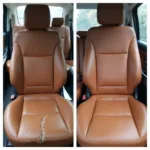Car seats endure a lot of wear and tear, from daily commutes and accidental spills to the inevitable effects of time. Knowing how to repair car seats can save you money and keep your car’s interior looking its best. This guide will walk you through various car seat repair techniques, common problems, and when to call in a professional.
Identifying the Damage: What Needs Fixing?
Before you start gathering materials, it’s crucial to identify the type of damage your car seats have sustained. This will determine the best course of action for repair.
- Tears, Rips, and Holes: These are common in fabric seats and can be caused by sharp objects, pet claws, or general wear and tear.
- Burns: Cigarettes and even hot objects can leave unsightly burn marks on your seats.
- Stains: Food, drinks, ink, and even dirt can lead to stubborn stains, especially on light-colored seats.
- Cracks and Fading: Leather and vinyl seats are prone to cracks and fading due to sun exposure and aging.
- Sagging and Loose Padding: Over time, the foam padding in car seats can lose its shape and support.
DIY Car Seat Repair: Tools and Techniques
Many car seat repairs can be tackled at home with the right tools and a bit of patience.
Repairing Tears and Rips in Fabric Seats
You will need:
- Upholstery repair kit (matching your seat fabric)
- Scissors
- Iron
Instructions:
- Clean the damaged area thoroughly.
- Cut a piece of backing fabric from the repair kit slightly larger than the tear.
- Apply adhesive to the backing fabric and carefully place it under the tear.
- Apply the heat-activated patch from the kit over the tear, following the manufacturer’s instructions.
Pro Tip: For small tears, consider using a fabric glue designed for upholstery. Apply a small amount under the tear, press the edges together, and allow it to dry completely.
Addressing Burns on Fabric Seats
You will need:
- Razor blade or fine-grit sandpaper
- Fabric matching your seat color
- Upholstery adhesive
Instructions:
- Carefully remove any loose debris or burnt fabric with the razor blade or sandpaper.
- Cut a small piece of matching fabric slightly larger than the burn mark.
- Apply upholstery adhesive to the back of the fabric and press it firmly onto the burn mark.
Fixing Cracks in Leather Seats
You will need:
- Leather repair kit (matching your seat color)
- Cleaning cloth
- Rubbing alcohol
Instructions:
- Clean the cracked area thoroughly with rubbing alcohol and let it dry.
- Follow the instructions provided with your chosen leather repair kit. This typically involves applying a leather filler to the crack, allowing it to dry, and then applying a color-matched sealant.
If you are interested in learning more about the cost of repairing leather car seats specifically, you can find detailed information in our guide on how much to repair leather car seats.
Dealing with Stains
You will need:
- Upholstery cleaner (appropriate for your seat material)
- Soft-bristled brush
- Microfiber cloth
- Water
Instructions:
- Vacuum the seats to remove any loose dirt or debris.
- Apply the upholstery cleaner to the stained area, following the product instructions.
- Gently scrub the stain with the brush.
- Wipe away the cleaner and dirt with a damp microfiber cloth.
- Repeat as needed and let the seats air dry.
Pro Tip: For stubborn stains, consider using a specialized stain remover designed for your specific seat material.
When to Seek Professional Help
While many car seat repairs can be done at home, some situations warrant professional intervention.
Consider taking your car to an upholstery specialist if:
- The damage is extensive or involves complex mechanisms like seatbelt pretensioners or airbags.
- You’re dealing with high-end materials like premium leather or Alcantara that require specialized care.
- You’re not comfortable tackling the repair yourself.
“Attempting a complex car seat repair without the proper knowledge and tools can lead to further damage and costly repairs down the road,” advises John Miller, a seasoned automotive upholsterer with over 20 years of experience. “It’s always best to err on the side of caution and consult a professional when dealing with intricate repairs.”
Preventing Future Damage: Proactive Care Tips
Preventing damage is always easier than fixing it. Here are some simple ways to protect your car seats and keep them looking their best:
- Use seat covers: Seat covers provide a barrier against spills, stains, and UV damage.
- Regular cleaning: Vacuum your seats regularly and address spills immediately to prevent staining.
- Condition leather seats: Use a leather conditioner every few months to keep your leather seats supple and prevent cracking.
- Park in the shade: When possible, park your car in the shade to minimize sun damage and fading.
Conclusion: Keep Your Car’s Interior Pristine
Learning how to repair car seats empowers you to take charge of your vehicle’s upkeep and preserve its value. By mastering these basic techniques and practicing proactive care, you can keep your car’s interior looking its best for years to come. Remember, knowing when to call in a professional for help ensures that even complex repairs are handled correctly.


